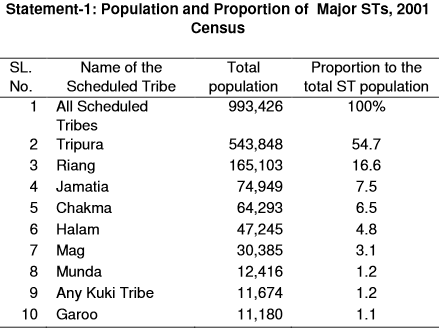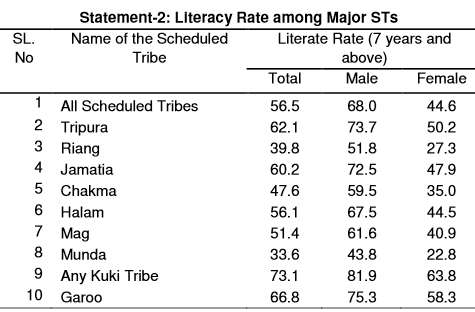Tripura
This article has been sourced from an authoritative, official readers who wish to update or add further details can do so on a ‘Part II’ of this article. |
Contents |
The source of this article
INDIA 2012
A REFERENCE ANNUAL
Compiled by
RESEARCH, REFERENCE AND TRAINING DIVISION
PUBLICATIONS DIVISION
MINISTRY OF INFORMATION AND BROADCASTING
GOVERNMENT OF INDIA
Tripura
Area : 10,491.69 sq km
Population : 31,99,203 (Census 2001) 3,671,032 (Prov. Census 2011)
Capital : Agartala
Principal Languages : Bengali and Kokborak
HISTORY
Tripura has its unique tribal culture and a fascinating folklore. The history of Tripura can be learnt from ‘Rajmala’ chronicles of king Tripura and writings of historians. There are references of Tripura even in the Mahabharata and the Puranas. According to ‘Rajmala’, the rulers were known by the surname ‘Fa’ meaning ‘father’. There is a reference to rulers of Bengal helping Tripura kings in the 14th century. Kings of Tripura had to face frequent Mughal invasions with varying successes. They defeated the Sultans of Bengal in several battles. Nineteenth century marked the beginning of the modern era in Tripura when king Maharaja Bir Chandra Kishore Manikya Bahadur modelled his administrative set-up on the British India pattern and brought in various reforms. His successors ruled Tripura till 15 October 1949 when the State merged with the Indian Union. Initially, a part 'C' State, it became a Centrally administered territory with the re-organisation of States in 1956. In 1972, Tripura attained the Status of a full-fledged state.
Tripura is strategically situated between the river valleys of Myanmar and Bangladesh. Encircled almost on three sides by Bangladesh, it is linked with Assam and Mizoram in the north-east.
AGRICULTURE
The economy of Tripura is primarily dependent on agriculture. 24% land of the State is being utilized by this sector. And as per the Census of 2001, 51% population is dependent on agriculture for their livelihood.
ASSEMBLY
March 2018, National anthem played for first time in Tripura Assembly
March 23, 2018: The Times of India
The national anthem was played for the first time in the Tripura Assembly. The first session of the newly elected House begun with the election of Speaker Rebati Mohan Das.
As soon as the House assembled at 11 and Pro-tem speaker Ratan Chakraborty arrived to conduct the Speaker's elections, the national anthem was played and all the ministers, members, officials, journalists and spectators stood up to show respect.
Assembly Secretary Bamdeb Majumder said they will try to play the national anthem every day.
"I do not know whether the national anthem was played in any other Assembly in the country," Majumder told IANS. Communist Party of India-Marxist legislator Badal Choudhury told IANS that the Assembly authorities did not consult the opposition on the issue.
IRRIGATION
Tripura is a predominantly hilly State having geographical area of 10,49,169 hectare. Amid the undulating terrain the recently assessed Land under cultivation is 2,55,241 hectares. Presently assessed Irrigable Land is 1,17,00 hectares. Area brought under Irrigation is 1,08,646 hectares up to 31st March, 2011, which is 92.86% of Irrigable area and 42.57% of cultivable land.
TOURISM
Tripura is a small but picturesque State in the North Eastern Region of the country. The area of the State is about 10,491,69 sq kms. To its North, South and South East Tripura have an international boundary with Bangladesh while to its East; it shares a common boundary with two Indian States of Assam and Mizoram. There are 19 ethnic tribes, Bengali, Manipuri and others, inhabit this panoramic tiny State.
The scenic beauty of Tripura, its rich and varied culture, archaeology and architecture, its handloom and handicraft which is exquisite in color, excellent in design and craftsmanship, its verdant forests, and lakes, its excellent bracing climatic conditions, its enhancing and abounding floral treasures and panoramic view points and above all its very hospitable ethnic population are so attractive that any one who visits the State once cannot resist his temptation to come offender.
GOVERNMENT
Governor : Dr. D.Y. Patil
Chief Secretary : Shri S.K. Panda
Chief Minister : Shri Manik Sarkar
Jurisdiction of High Court: Falls under Guwahati High Court Agartala Bench
AREA, POPULATION AND HEADQUARTERS OF DISTRICTS
S. No. District Area (sq km) Population Headquarters (As per Prov. 2011 Census)
1. North Tripura 2,820.63 5,90,913 Kailashahar
2. South Tripura 2,151.77 7,67,440 Udaipur
3. West Tripura 2,996.82 15,32,982 Agartala
4. Dhalai 2,552.47 3,07,868 Jawaharnagar,
Ambassa
Total 10,491.69 31,99,203
Tripura: The Scheduled Tribes Census of India 2001
The total population of Tripura in 2001 Census has be en 3,199,203. Of these 993,426 persons are Scheduled Tribes (STs) constituting 3 1.1 per cent of the total population. The state has registered 16.4 per cent de cadal growth of ST population in 1991-2001. There are nineteen (19) notified STs in t he state.
Population: Size & Distribution
2.Tripura, the main ST in the state from which the s tate has earned its name ‘Tripura’, alone accounts for more than half of the t otal ST population of the state (54.7 per cent). Riang (16.6 per cent), Jamatia (7.5 per cent ), Chakma (6.5 per cent), Halam (4.8 per cent), Mag (3.1 per cent), Munda (1.2 per cen t), Any Kuki Tribe (1.2 per cent), and Garoo (1.1 per cent) are the other major STs in t erms of population. Along with Tripura they constitute about 97 per cent ST populatio n of the state (Statement-1). The rest of the STs are small in population size.
3.The STs in the state are predominantly rural (97.4 per cent). One third of the total ST population of the state is living in West Tri pura district (39 per cent), followed by South Tripura (29.1 per cent), Dhalai (16.7 per cent ), and North Tripura (15.1 per cent). Dhalai district, however, has recorded the highest propo rtion (54 per cent) of ST population.
Sex Ratio
4.As per 2001 Census, sex ratio of the ST population is 970, which is below the national average for STs (978). The Jamatia has recorde d the highest sex ratio of 996 among the major STs. On the other hand comparatively low sex ratio has been recorded among Munda (950), Chakma (951), and Riang (962).
5.The child sex ratio (0-6 age group) for the STs in the state (981) is higher than the corresponding aggregated national average (973). It is important to note that while Jamatia has recorded a high overall sex ratio, the child sex ratio (958) among them is comparatively low. This situation is just the opposite a mong Chakma.
Literacy & Educational Level
6.Among all STs, 56.5 per cent of the population has b een recorded as literate, which is higher than the national average for STs (471 per cent). The male literacy rate of 68 per cent and female of 44.6 per cent show high g ender disparity in literacy.
7.Any Kuki Tribe with 73.1 per cent literacy rate is w ell ahead of other major STs. The Tripura has recorded literacy rate of 62.1 per cen t with male and female literacy rate of 81.9 per cent and 63.8 per cent respectively. On th e other hand more than half of the population among Munda, Riang, and Chakma are illite rate (Statement-2).
8.Among all STs, 62.7 per cent of the children in age group 5-14 years have been attending schools or any other educational institutions. Any Kuki Tribe have recorded the highest (77.6 per cent) and Munda the lowest (36.7 per cent) percentage attending schools or any other educational institutions. 9.As regards level of education, merely 9.5 per cent of total literates among STs are having educational level of Matric/Secondary and a bove. Among the major STs, Tripura have 10.5 per cent of their total literates a s matriculates, while among Munda (4 per cent), Riang (5.7 per cent), and Mag (6.5 per cent) this percentage is low.
Work Participation Rate (WPR)
10.In 2001 Census, 42.7 per cent of the ST population has been recorded as workers, which is lower than the aggregated national average for STs (49.1 per cent). Of the total workers, 69.6 per cent have been recorded a s main workers and 30.4 per cent as marginal workers. WPR of 37.5 per cent among female s is slightly lower than that of males (47.6 per cent). Gender wise disparity, however, is paramount in case of main workers; 86.5 per cent among males and only 47.5 per cent among females have been recorded as main workers (Statement-3).
11.Individual ST wise Jamatia have recorded the highest WPR (48.7 per cent). On the other hand it is the lowest among Riang (39.2 per cent).
Category of Workers
12.Agriculture is the mainstay of economic activities amo ng the STs in Tripura. Among all STs, 45.9 per cent of the total main worker s have been recorded as cultivators and 29.7 per cent agricultural labourers. 13.The Riang are predominantly involved in cultivati on with the highest of 64.9 per cent of their total main workers as cultivators among th e major STs. On the other hand it is the lowest among Munda (12 per cent).
Marital Status
14.The distribution of ST population by marital statu s shows that 54.3 per cent is never married, 41.9 per cent currently married, 3.3 p er cent widowed, and 0.6 per cent divorced/separated.
15.The percentage of widowed population among Garoo (4.4 per cent) and Munda (4.1 per cent) is considerably high. As regards the divorced/ separated population, Mag have recorded the highest 1.1 per cen t, while Chakma the lowest at 0.3 per cent among the major STs (Statement-4).
16.Among all STs, 1.4 per cent of the total females b elow 18 years – the minimum legal age for marriage – have been returned as ever married. The Munda have recorded the highest 1.9 per cent ever married females below t he stipulated age for marriage.
17.The ever married males below 21 years – their mini mum legal age for marriage – constitute 1.7 per cent of their total pop ulation. The Riang have recorded the highest 2.3 per cent ever married males in this categor y, closely followed by Jamatia (2 per cent). It is the lowest among Garoo (0.9 per cent).
Religion
18.Of the total ST population 80.1 per cent are Hind us, 10 per cent Christians, 9.6 per cent Buddhists, and only 0.2 per cent Muslims.



